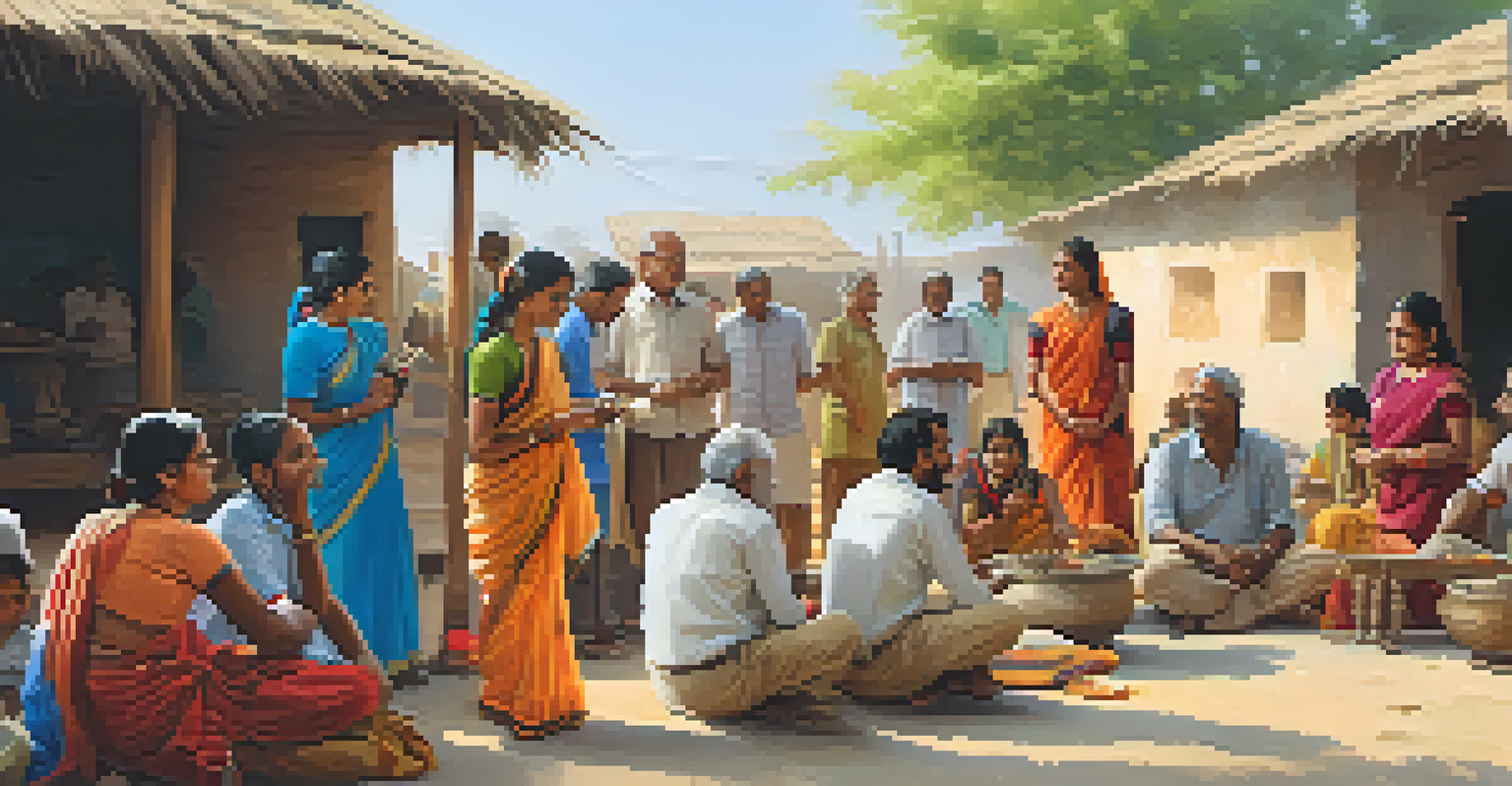Heritage Trail Mapping: Engaging Local Communities in India

Understanding Heritage Trail Mapping in India
Heritage trail mapping is a process that involves documenting and showcasing the historical and cultural significance of various locations. In India, a land rich with diverse traditions and histories, this practice helps illuminate the stories hidden within its landscapes. By mapping these trails, communities can create a narrative that honors their heritage while attracting visitors who are eager to explore.
Heritage is our legacy from the past, what we live with today, and what we pass on to future generations.
This initiative goes beyond mere tourism; it fosters a deeper connection between locals and their cultural roots. By actively participating in the mapping process, community members gain a sense of pride and ownership over their history. Moreover, it encourages them to share their unique narratives with the world, creating a vibrant tapestry of local stories.
Ultimately, heritage trail mapping serves as a bridge between the past and the present, encouraging intergenerational dialogue. It allows younger generations to appreciate their heritage while also providing opportunities for older generations to share wisdom and knowledge. This engagement is crucial in preserving the essence of local cultures and histories.
Benefits of Engaging Local Communities
Engaging local communities in heritage trail mapping offers numerous benefits, both culturally and economically. Firstly, it empowers residents to take an active role in preserving their history, which can lead to increased community cohesion. When locals are involved, they are more likely to advocate for the conservation of their heritage sites, ensuring they are maintained for future generations.

Additionally, this engagement opens up pathways for economic development through cultural tourism. As trails attract visitors, local businesses such as restaurants, artisans, and tour guides can thrive. This influx of tourism not only boosts the local economy but also creates jobs, further solidifying the community's investment in their heritage.
Heritage Mapping Connects Communities
Engaging locals in heritage trail mapping fosters a sense of pride and ownership over their cultural histories.
Moreover, engaging locals fosters a spirit of collaboration and creativity. When people come together to share ideas and resources, they can develop innovative ways to present their culture. This collaborative effort can result in unique events, festivals, and activities that draw even more attention to their heritage, enriching the community experience.
Incorporating Technology in Heritage Mapping
Technology plays a pivotal role in modern heritage trail mapping, making it easier to document and share cultural narratives. Through the use of Geographic Information Systems (GIS), communities can create interactive maps that highlight significant sites and stories. This not only enhances the experience for visitors but also allows locals to visualize their heritage in a new light.
The preservation of our heritage is not a task for the faint-hearted; it requires passion, dedication, and a commitment to community.
Social media platforms are also powerful tools for promoting these trails. By sharing images, stories, and experiences online, communities can reach a wider audience, attracting visitors who might not have otherwise known about their unique heritage. This digital outreach is vital in today's connected world, where information spreads quickly.
Furthermore, mobile apps can provide real-time information about heritage trails, guiding visitors through their journey while sharing historical insights. This tech-savvy approach not only enriches the visitor experience but also encourages locals to engage with their surroundings in innovative ways, bridging the gap between traditional practices and modern conveniences.
Case Studies: Successful Heritage Trails in India
Several successful heritage trails across India exemplify the positive impact of community engagement. For instance, the 'Heritage Walk' in Ahmedabad invites locals and tourists alike to explore the city’s architectural marvels and cultural landmarks. This initiative engages participants in storytelling sessions, enhancing their connection to the city’s rich history.
Similarly, the 'Bihar Heritage Walk' highlights the region's ancient sites, including temples and palaces. This project not only emphasizes the architectural beauty of the area but also involves local artisans in the process, allowing them to showcase their crafts. Such collaborations create a vibrant atmosphere that celebrates both history and contemporary culture.
Economic Boost from Cultural Tourism
Heritage trails can drive economic growth by attracting visitors and supporting local businesses.
These case studies illustrate that when communities come together to map and promote their heritage, they can create powerful narratives that resonate with both local and global audiences. The success of these trails encourages other regions to adopt similar initiatives, fostering a nationwide appreciation for India's diverse cultural landscape.
Challenges in Heritage Trail Mapping
Despite the numerous benefits, heritage trail mapping in India faces several challenges. One significant hurdle is the lack of resources and funding, which can hinder the development of comprehensive trails. Many local communities may not have the financial means to initiate these projects, limiting their ability to showcase their heritage effectively.
Additionally, there can be resistance from some community members who may feel that their stories are not being accurately represented. It's crucial for mapping projects to involve a diverse range of voices to ensure that the narratives being shared are inclusive and representative of the entire community. This can often require extensive outreach and education efforts.
Moreover, balancing tourism with preservation can be tricky. While attracting visitors is essential for economic growth, it’s vital to manage the impact of tourism on heritage sites to prevent degradation. Communities must find sustainable ways to promote their culture while protecting the integrity of their historical landmarks.
The Role of Government and NGOs
Government support and involvement are essential for the successful implementation of heritage trail mapping. By providing funding, resources, and technical assistance, local governments can empower communities to undertake these projects effectively. Policies that promote cultural heritage and tourism can help create a conducive environment for such initiatives to flourish.
Non-governmental organizations (NGOs) also play a significant role in supporting community-driven heritage mapping efforts. They can provide expertise in project management, training, and capacity building, helping residents develop the skills necessary for successful implementation. These partnerships can prove invaluable in navigating the complexities of heritage preservation.
Technology Enhances Heritage Experience
Innovative tools like GIS and mobile apps enrich the documentation and sharing of cultural narratives.
Furthermore, NGOs can assist in raising awareness about the importance of cultural heritage, fostering a sense of pride among community members. By highlighting the significance of preserving local narratives, these organizations can motivate residents to participate actively in heritage trail mapping, ensuring that their stories are shared and celebrated.
Future of Heritage Trail Mapping in India
The future of heritage trail mapping in India looks promising, particularly as communities become more aware of the importance of their cultural narratives. With increasing interest in sustainable tourism, more locals are likely to engage in documenting their histories and sharing them with the world. This shift towards valuing cultural heritage can lead to stronger communities and more vibrant local economies.
Innovations in technology will also continue to shape the way heritage trails are mapped and experienced. As virtual reality and augmented reality tools become more accessible, they can provide immersive experiences that draw in visitors and deepen their understanding of local histories. This technological integration can enhance the storytelling aspect of heritage trails, making them even more appealing.

Ultimately, the ongoing collaboration between communities, governments, and NGOs will be crucial in sustaining these efforts. By fostering a collective commitment to preserving cultural heritage, India can ensure that its diverse narratives are celebrated for generations to come. The future of heritage trail mapping holds the potential to transform communities, making them more resilient and connected through their shared histories.